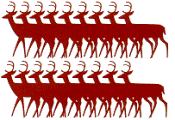United States Department of Agriculture, National Wildlife Research Center: Symposia

Contraception in Wildlife Management
Date of this Version
October 1993
Abstract
lmmunocontraception may have management application for white-tailed deer populations in parks and preserves. where hunting 1s illegal or impractical. This study examines physiological aspects of immunocontraception with porcine zonae pellucidae in 53 fertile white-tailed does. In separate studies, we employed protocols of three and two porcine zonae pellucidae (PZP) injections as well as two different protocols using one injection. Each one-injection vaccination consisted of one dose of porcine zonae pellucidae as in other protocols plus a second controlled-release dose of the material delivered via an osmotic minipump implant or injected, biodegradable polymer microspheres. We monitored fawn production for 1 to 3 years in all does and measured serum PZP antibody titers at various times after treatment in 15 randomly selected PZP does and in 2 control does. All three-injection PZP does were give a single PZP booster inoculation after 1 year. None of the two- or three-injection does and none of the one-injection does with a minipump produced fawns the first year after treatment, whereas two of seven does given a single injection with controlled-release microspheres produced fawns. In 49 control-doe breeding seasons, the pooled incidence of fawn production was 93.8 percent. Regarding reversibility of infertility, the incidence of fawn production was 75 % within 2 years after treatment was discontinued. Serum anti-PZP antibody titers were present only after PZP treatment, and highest titers occurred in does given two or three separate PZP injections. PZP-treated does showing >50% of maximal antibody titers at the onset of a breeding season did not produce fawns; those showing <33% of maximal titers did. These data demonstrate in white-tailed does that (1)multiple-injection PZP vaccination can produce complete contraception for at least one breeding season, (2) the contraceptive effect is reversible within 2 years in most does, (3) an elevated anti-PZP antibody titer occurs after PZP vaccination, and (4) multiple-injection PZP vaccination produces a sustained antibody response through at least one breeding season. In separate field studies of wild, free-roaming deer in three locations, we successfully lured does to within darting range using bait stations. In two locations, we attempted and achieved remote delivery PZP vaccination of 60-9- percent of does. In the one location for which we have data on fawn production, the fawning incidence was 0/10, 6/9, and 8/9 for two- and one-injection porcine zonae pellucidae and untreated controls, respectively. In the same location, we monitored seasonal aspects of activity, behavior, and physical condition. We also determined that there is a good potential for remote assessment of pregnancy in does using measurement of pregnancy-specific elevations of steroid metabolites in fecal samples.


Comments
Contraception in wildlife management. APHIS Technical Bulletin No. 1853. USDA, Animal and Plant Health Inspection Service, Washington, D.C., USA.